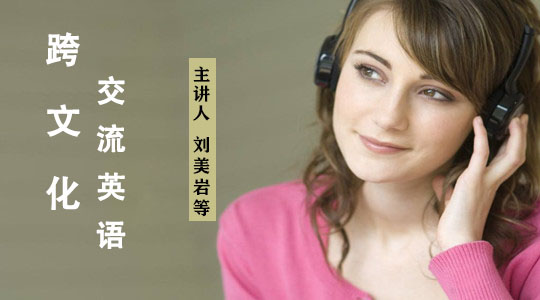
当前课程知识点:跨文化交流英语 > Unit 7 Fashion > Part VI. Listening Test > Unit Seven: Part VI. Listening Test
Unit Seven: Part VI. Listening Test
Part I Long Conversations
Directions: In this part, you will hear two long conversations. After each conversation, there will be some questions. Both the conversation and the questions will be read only once. Listen carefully and choose the best answer to each question.
Conversation 1
M: Well, what about this clothes, Melissa? Like, are you a brand name person?
W: No, not at all. That's not my style.
M: Yeah, so what determines your style? What influences you?
W: Well, when I go shopping, I usually have something in mind that I want to buy, so either a certain color or just a certain item of clothing and then I look around at all the different shops and compare the best prices and things like that, and then I'll buy the one that's the best deal and I'll feel really good about it.
M: So for your style, do you look around and say, "Oh, I like what that person's wearing. I wanna dress this style" or do you just think, you have your own style and you don't care if it fits into a mold.
W: I think it's a mix. I think that sometimes I'll see something that someone's wearing and I'll like it or want something similar and then of course that mixes in with things I already have, but I also like to make my own clothes, and remake clothes and things like that, so sometimes I'll remake something and realize that I need a sweater or something to go with it and then I'll just buy it based on something else I already have.
M: Oh, so you make your own clothes.
W: Yeah. Sometimes I'll go to a craft store and buy fabric and then cut it up and make a shirt from fabric, but often take a shirt or pants I already have and make into something. Like, I recently was living with a couple of roommates and my roommate was getting rid of all her old jeans so I cut her jeans up and cut a sweater up I had and then I made it into a jacket.
M: Oh, nice.
W: Yeah.
M: And you still have it.
W: Totally. I wear it all time.
M: Cool. Alright, well, thanks Melissa.
Melissa: No problem.
Questions:
1. What kind of clothes does Melissa like when she goes shopping?
A. Popular style.
B. Handmade.
C. Famous brand.
D. The best deal.
2. Which of the following is not true about Melissa?
A. She’ll never buy something that someone is wearing.
B. She has her own style.
C. She likes to make her own clothes.
D. She is a rational consumer.
3. What is the possible relationship between the two speakers?
A. Colleagues.
B. Close friends.
C. A reporter and a pop star.
D. A director and an actress.
Conversation 2
W: Oh, what happened to your face, John? It looks like a heat rash.
M: It's a razor burn. I cut myself when I shaved this morning. The burns and cuts are really irritating.
W: Maybe you shouldn't have grown a long, long beard.
M: Well, I thought it would be fun and would make me look more mature and sophisticated.
W: Yeah, my Mature man!
M: Come on! Any advice?
W: Maybe you could shave in the shower. The steam really helps soften your beard and moustache.
M: Hm, sounds like a good idea.
W: And you should avoid pressing too hard on your skin while shaving.
M: I guess I've been stretching it too often when I shave.
W: Hm. I would also suggest you try this cream. Use it on the affected area. It really helps moisturize your skin and lessen irritations.
Questions:
4. What happened to John?
A. He got a heat rash.
B. He got sunburn.
C. He cut himself when using a razor.
D. None of the above.
5. What does John think of his long beard?
A. It makes him look charming.
B. It makes him look complicated.
C. It makes him look mature.
D. It makes him look funny.
6. Which of the following is not the advice given by the woman?
A. Stop Pressing too hard on the skin while shaving.
B. Stop shaving too often.
C. Shave in the shower.
D. Use some cream.
Par t II Short Passages
Directions: In this part, you are going to hear three short passages. After each passage, there’ll be some questions. Both the passage and the questions will be read only once. Listen carefully and choose the best answer to each question you’ve heard.
Passage 1
Clothing is something we all should wear in order to fit into society. Clothes are easily accessible and can be bought in most high street shops. Supermarkets are also beginning to sell clothes. Clothes are for keeping people warm or serving as protection from the strong burning sun. Certain items of clothing can be expensive, especially if it is made by a well-known brand or is a particular design. While clothing is affordable for most people, the price usually depends on the quality of the material used to make the item and its brand name. In most countries clothing is taxed, while food is not. This is probably because clothing can be considered as a luxury item, especially if it is of very good quality.
The type of clothing that is worn usually depends on the occasion. People that attend a wedding usually wear formal clothes. Men often wear suits and women wear dresses. Formal and smart clothing is often worn in times of celebration. People often wear different clothing at work. Some jobs require people to wear a special uniform which should be worn by all employees. A pilot, doctor or air hostess may be required to wear a uniform so that all the staff can be easily recognized. Other jobs are less strict and may allow people to wear casual clothes. Construction workers are usually asked to wear protective clothing, especially when the site is considered highly dangerous.
People often choose to wear comfortable clothing inside their own home. This choice of clothing may be very different to the clothing they would normally wear outside. Some people even stay in their bedclothes all day on the weekend when they plan to relax and not go anywhere. People often wear clothing which matches their current state of health or their age. Pregnant women are likely to wear baggy clothes, while youths often wear tighter clothing to show their figure. Younger females often wear high heeled shoes while elderly people tend to wear more comfortable shoes which will allow them to walk with ease.
Questions:
7. When can items of clothing be expensive?
A. When they are from the supermarket.
B. When they are taxed too much.
C. When it is a well-known brand or design.
D. When they are in the sale.
8. What kind of job requires workers to wear protective clothing?
A. Pilots
B. Construction workers
C. Doctors
D. Air hostess
9. How do some youths usually like to wear their clothes?
A. Baggy
B. Tight
C. Short
D. Long
10. What type of clothing is worn in times of celebration?
A. Formal
B. Casual
C. Protective
D. Bedclothes
11. Who is more likely to wear baggy clothing?
A. Youths
B. Workers
C. Pregnant ladies
D. Elderly people
Passage 2
The beginning of fashion and changing clothing in Europe can be dated to the middle of 14th century. The pace of change accelerated in the following century and women and men's fashion became complex and changing.
Although tailors and dressmakers were no doubt responsible for many innovations before, the textile industry certainly has been very influential. The four major fashion capitals are known to be Milan, New York city, Paris, and London. Fashion weeks are held in these cities where designers exhibit their new clothing collections to audiences.
Modern westerners have a wide choice available in the selection of their clothes .What a person chooses to wear can reflect that person's personality or likes. When people who have cultural status start to wear new or different clothes, a fashion trend may start. People who like them may start to wear clothes of a similar style.
Fashions may vary considerably within a society according to age, social class, generation, occupation and geography as well as over time. If, for example, an older person dresses according to the fashion of young people, he or she may look ridiculous in the eyes of both young and older people.
Though colors and patterns of textiles changed from year to year, the cut of a gentleman's coat or the pattern to which a lady's dress was cut changed more slowly. Men's fashions largely derived from military models. Women's fashions mainly derived from geographical and regional customs.
Questions:
12. Which of the following cities has not been among the major fashion capitals?
A. Paris
B. Milan
C. New York
D. Rome
13. A fashion trend may start when________?
A. An important person starts to wear different clothes.
B. An important person has a wide choice available in clothes.
C. The pace of change accelerates.
D. Fashion weeks are held in fashion capitals.
14. Fashion changes according to all the following except_________.
A. Occupation
B. Generation
C. Art
D. Social class
15. What was the main source of men's fashion in the past?
A. Military models
B. Regional customs
C. Magazines
D. Geography
Passage 3
Fashion is something we deal with every day. Even people who say they don’t care what they wear choose clothes every morning that say a lot about them and how they feel that day.
One certain thing in the fashion world is change. We are constantly being bombarded with new fashion ideas from music, videos, books, and television. Movies also have a big impact on what people wear. Ray-Ban sold more sunglasses after the movie Men in Black.
Who dictates fashion? Musicians and other cultural icons have always influenced what we're wearing, but so have political figures and royalty. Newspapers and magazines report on what Hillary Clinton wears. The death of Diana, the princess of Wales, was a severe blow to the high fashion world, where her clothes were daily news.
Fashion is revealing. Clothes reveal what groups people are in, but they also create stereotypes and distance between groups.
Fashion is a language which tells a story about the person who wears it. “Clothes create a wordless means of communication that we all understand," according to Katherine Harnett, a top British fashion designer.
Clothing can also be used as a political weapon. In nineteenth century England, laws prohibited people from wearing clothes produced in France. During twentieth century communist revolutions, uniforms were used to abolish class and race distinctions.
Questions:
16. Which of the following is not mentioned as one of the sources of new fashion ideas?
A. Books.
B. Music.
C. Internet.
D. Movie
17. Who may influence fashion?
A. The royals.
B. Political figures.
C. Cultural icons.
D. All of the above.
18. Which of the following is not true according to the passage?
A. Clothes separate people into groups.
B. Clothing is seldom used as a political weapon.
C. Clothes may tell stories about the people who wear it.
D. Clothes may create stereotypes and distance between groups.
-Part I. Understanding cultural differences
--Part I. Understanding cultural differences
--Exercise: Oral work
-Exercise: fill in the blanks
-Part II. Building intercultural awareness
--Part II. Building intercultural awareness
-Part III. Adapting to a new culture
--Part III. Adapting to a new culture
-Part IV. Discussion:How to adapt to a new culture.
--Part IV.Discussion:How to Adapt to a New Culture
-Part V. Functional English: Making request
--Part V. Functional English: Making Request
-Part VI. Listening Test
--Unit One: Part VI. Listening Test
-Part VI. Listening test-作业
-Part I: Dining Etiquette
-Exercise: fill in the blanks
-Part II. Online etiquette
-Part III. Comparison of Chinese Etiquette and Western Etiquette
--Part III. Comparison of Chinese Etiquette and Western Etiquette
--Exercise: Oral work
-Part IV. Discussion:Chinese Dining Etiquette
--Part IV. Discussion: Chinese Dining Etiquette
-Part V. Functional English: Promising and Refusing
--Part V. Functional English: Promising and Refusing
--html
-Part VI. Listening Test
--Unit Two: Part VI. Listening Test
-Part VI. Listening Test-作业
-Part I. U.S Wedding Customs
-Exercise: Oral work
-Part II. Chinese Wedding Customs & Rituals
--Part II. Chinese Wedding Customs & Rituals
-Exercise:Oral work
-Part III. Fascinating wedding traditions around the world
--Part III. Fascinating wedding traditions around the world
-Exercise: fill in the blanks
-Part IV. Discussion: Differences between American Weddings and Chinese Weddings
--Part IV. A Conversation about the differences between American wedding and Chinese wedding
-Part V. Functional English: Expressing Congratulations
--Part V. Functional English: Expressing Congratulations
-Part VI. Listening Test
--Unit Three: Part VI. Listening Test
-Part VI. Listening Test
-Part I. What is Non-verbal Communication
--Part I. What is Non-verbal Communication
--Exercise: Oral work
-Part II. How to read body language
--Part II. How to read body language
-Exercise:True of false
-Part III. Non-verbal communication across cultures
--Part III. Non-verbal communication across cultures
-Part IV. Differences in hand gestures between China and America
--Part IV. Differences in hand gestures between China and America
-Part V. Functional English: Giving Suggestions and Warnings
--Part V. Functional English: Giving Suggestions and Warnings
-Part VI. Listening Test
--Unit Four: Part VI. Listening Test
-Part VI. Listening test-作业
-Part I. Reasons and Means of Transportation for Travel
--Exercise: Oral work
-Part II. Tourist Atractions
--Part II. Means of transportation for travel
-Part III. Travel Experiences
--Part III. Tourist attractions
--Exercise: fill in the blanks
-Part IV.Discussion: Travel Experiences
-Part V. Functional English : Giving invitations
--Part V. Functional English : Giving invitations
-Part VI. Listening Test
--Unit Five: Part VI. Listening Test
-Part VI. Listening Test-作业
-Part I. Music and Life
--Exercise: Oral work
-Part II. Different Genres of Music
--Part II. Different Genres of Music
-Part III. Musical Instruments
--Part III. Musical Instruments
--Exercise: fill in the blanks
-Part IV. Discussion: Your Favorite Musicians
--Part IV. Your Favorite Musicians
-Part V. Functional English : Expressing Likes and Dislikes
--Part V. Functional English : Expressing Likes and Dislikes
-Part VI. Listening Test
--Unit Six: Part VI. Listening Test
--html
-Part VI. Listening Test-作业
-Part I. Clothes make the man
--Part I. Clothes make the man
-Part II. Fast fashion
--Exercise: Oral work
-Part III. Fashion Trends and Tips
--Part III. Fashion Trends and Tips
-Exercise: fill in the blanks
-Part IV. A discussion on dress code and styles
--Part IV. A discussion on dress code and styles
-Part V. Functional English: Bargaining
--Part V. Functional English: Bargaining
-Part VI. Listening Test
--Unit Seven: Part VI. Listening Test
-Part VI. Listening Test-作业
-Part I Do you exercise, work out or do body building?
--Part I Do you exercise, work out or do body building?
-Part II CrossFit—a trendy way of keeping fit
--Part II CrossFit—a trendy way of keeping fit
-Exercise: fill in the blanks
-Part III. Motivation for fitness
--Part III. Motivation for fitness
-Part IV. Discussion: Doing Physical Exercises
--Part IV. A Conversation about doing physical exercises
-Part V. Functional English: Showing Anxiety and Worries
--Part V. Functional English: Showing Anxiety and Worries
-Part VI. Listening Test
--Unit Eight: Part VI. Listening Test
-Part VI. Listening Test-作业
-Part I: Introduction
-Exercise: Multiple choice
-Part II. The real college life
--Part II. The real college life
--Exercise: Oral work
-Part III. The changes of college education
--Part III. The changes of college education
-Listening exercise
-Part IV. Differences between American and Chinese college education
--Part IV. Differences between American and Chinese college education
-Part V. Functional English: Making complains
--Part V. Functional English: Making complains
-Part VI. Listening Test
--Unit Nine: Part VI. Listening Test
-Part VI. Listening Test-作业
-Part I: Introduction
-Part II. The Importance of Public Speaking
--Part II. The Importance of Public Speaking
--Exercise: Oral work
-Part III. Make an impressive speech
--Part III. Make an impressive speech
--Exercise: Oral work
-Part IV. Fighting stage fright
--Part IV. Fighting stage fright
-Part V. Functional English: Agreeing and disagreeing
--Part V. Functional English: Agreeing and disagreeing
-Part VI. Listening Test
--Unit Ten: Part VI. Listening Test
-Part VI. Listening Test—作业




